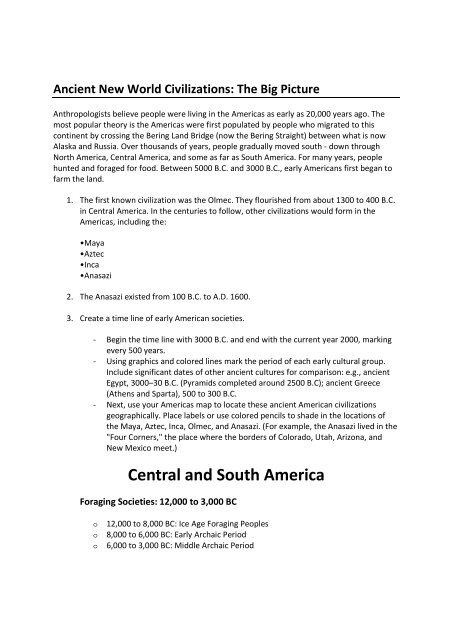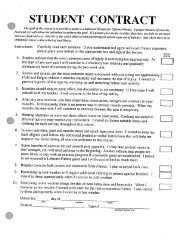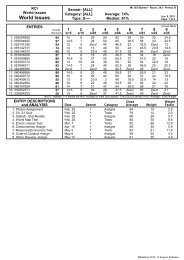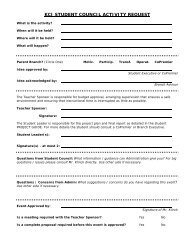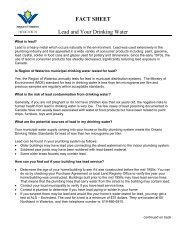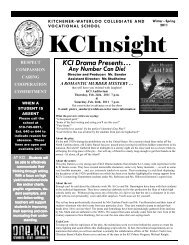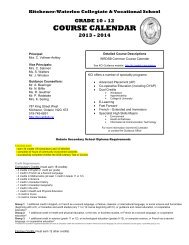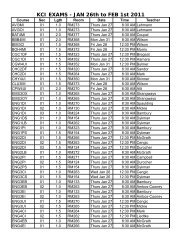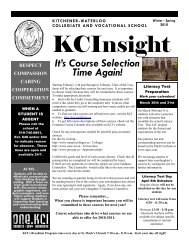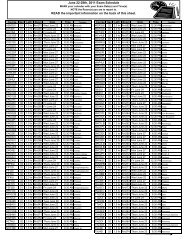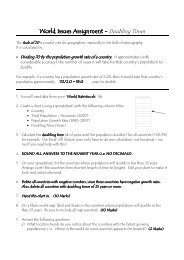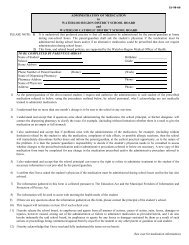Ancient Civilizations Assignment _Detailed Description_
Ancient Civilizations Assignment _Detailed Description_
Ancient Civilizations Assignment _Detailed Description_
You also want an ePaper? Increase the reach of your titles
YUMPU automatically turns print PDFs into web optimized ePapers that Google loves.
<strong>Ancient</strong> New World <strong>Civilizations</strong>: The Big Picture<br />
Anthropologists believe people were living in the Americas as early as 20,000 years ago. The<br />
most popular theory is the Americas were first populated by people who migrated to this<br />
continent by crossing the Bering Land Bridge (now the Bering Straight) between what is now<br />
Alaska and Russia. Over thousands of years, people gradually moved south - down through<br />
North America, Central America, and some as far as South America. For many years, people<br />
hunted and foraged for food. Between 5000 B.C. and 3000 B.C., early Americans first began to<br />
farm the land.<br />
1. The first known civilization was the Olmec. They flourished from about 1300 to 400 B.C.<br />
in Central America. In the centuries to follow, other civilizations would form in the<br />
Americas, including the:<br />
•Maya<br />
•Aztec<br />
•Inca<br />
•Anasazi<br />
2. The Anasazi existed from 100 B.C. to A.D. 1600.<br />
3. Create a time line of early American societies.<br />
- Begin the time line with 3000 B.C. and end with the current year 2000, marking<br />
every 500 years.<br />
- Using graphics and colored lines mark the period of each early cultural group.<br />
Include significant dates of other ancient cultures for comparison: e.g., ancient<br />
Egypt, 3000–30 B.C. (Pyramids completed around 2500 B.C); ancient Greece<br />
(Athens and Sparta), 500 to 300 B.C.<br />
- Next, use your Americas map to locate these ancient American civilizations<br />
geographically. Place labels or use colored pencils to shade in the locations of<br />
the Maya, Aztec, Inca, Olmec, and Anasazi. (For example, the Anasazi lived in the<br />
"Four Corners," the place where the borders of Colorado, Utah, Arizona, and<br />
New Mexico meet.)<br />
Central and South America<br />
Foraging Societies: 12,000 to 3,000 BC<br />
o 12,000 to 8,000 BC: Ice Age Foraging Peoples<br />
o 8,000 to 6,000 BC: Early Archaic Period<br />
o 6,000 to 3,000 BC: Middle Archaic Period
Settled Agriculture: 5,000 BC<br />
o 5000 BC: early agriculture begins in Mexico<br />
Early Ceremonial Centers: 2,000 BC to 700 BC<br />
o 2000 BC: Development of the first Peruvian ceremonial centers<br />
o 1500 BC: Beginnings of Olmec civilization<br />
Urban Society: 900 BC to AD 400<br />
o 900 BC: Chavins unite Peru<br />
o 800 BC: Olmecs unite Mesoamerica<br />
o 300: End of Olmec civilization<br />
Beginnings of Empire: 300-1400<br />
o 300-600: Teotihuacan (Toltec) Empire<br />
o 300: Beginnings of Mayan civilization<br />
o c. 550: Chichen Itza is founded<br />
o 600-800: Huari and Tiahuanaco Empires<br />
o 1300: End of Mayan civilization<br />
Later Empires: 1400-1810<br />
o 1400-1519: Aztec Empire<br />
o 1438-1538: Inca Empire<br />
o 1519-1810: Spanish Empire<br />
To present day: Independent National States<br />
o 1776: the US created the Declaration of Independence, creating the USA – 13<br />
colonies or “states” created<br />
o 1867: Canada becomes a country – New Brunswick, Nova Scotia, Ontario,<br />
Quebec were the original provinces (other provinces and territories joined later)
Marks<br />
Timeline (20) – accuracy (10)<br />
- detail (5)<br />
- creativity (5)<br />
Map (10) - accuracy (7)<br />
- map essentials (3)


